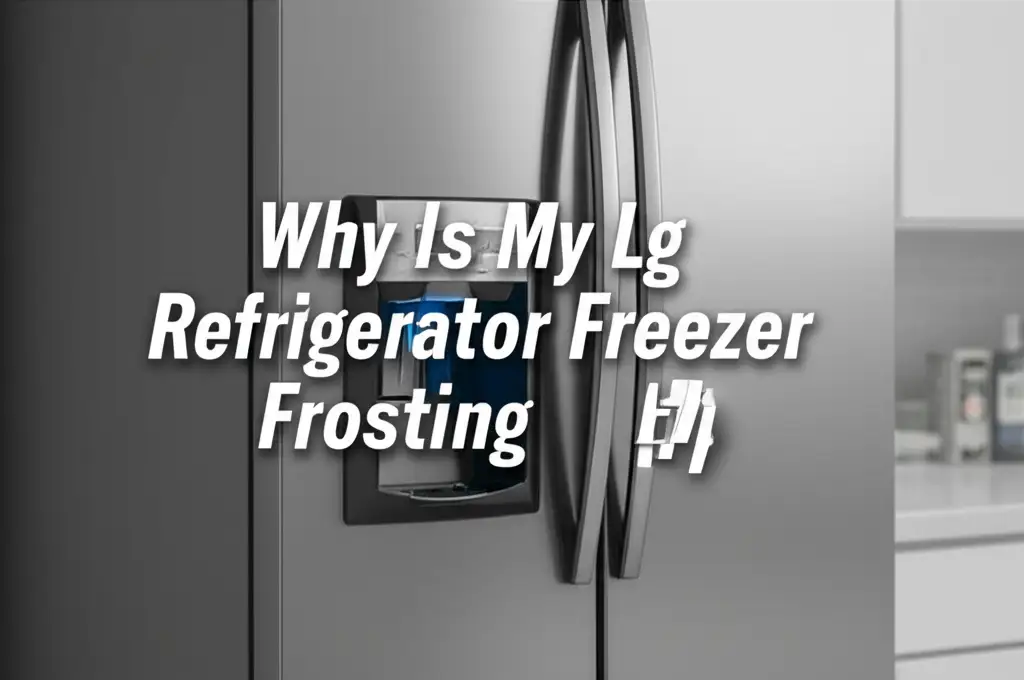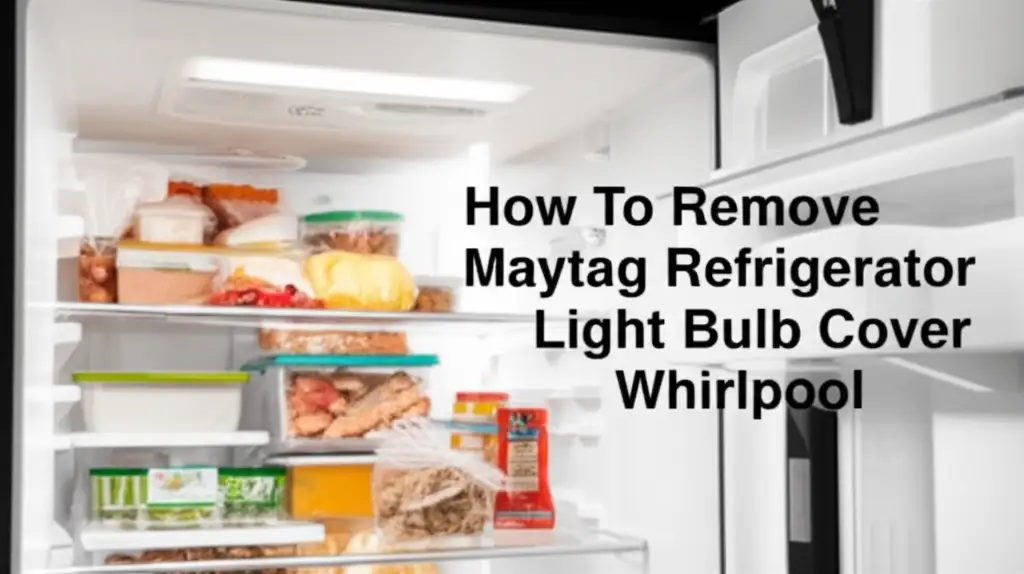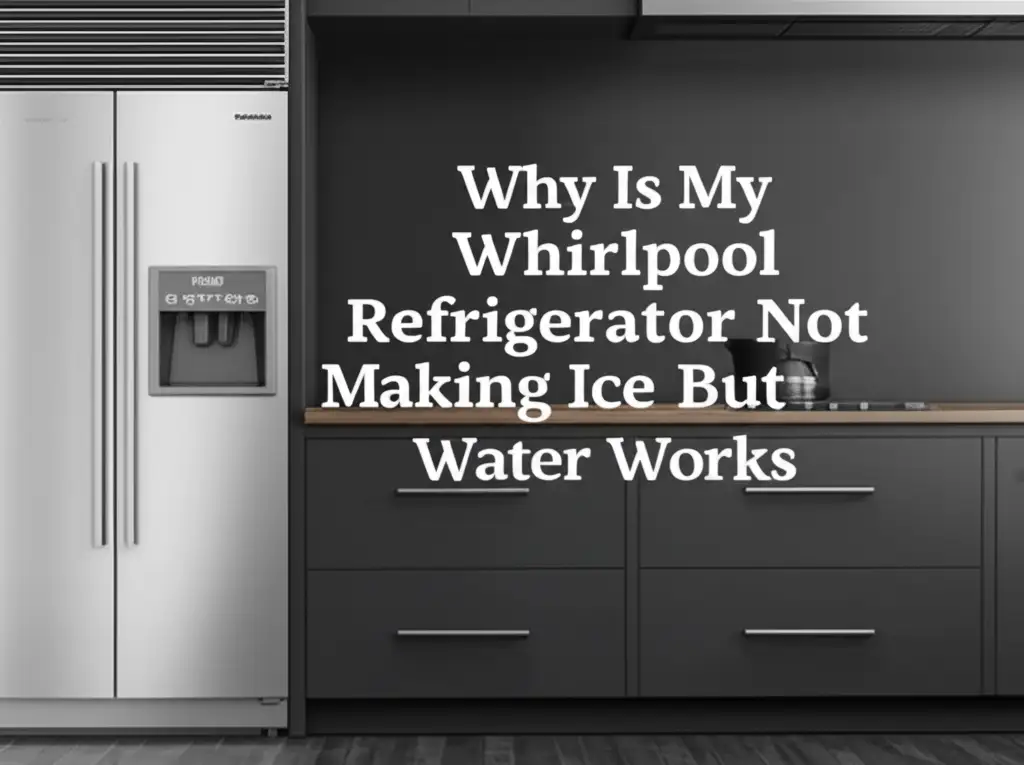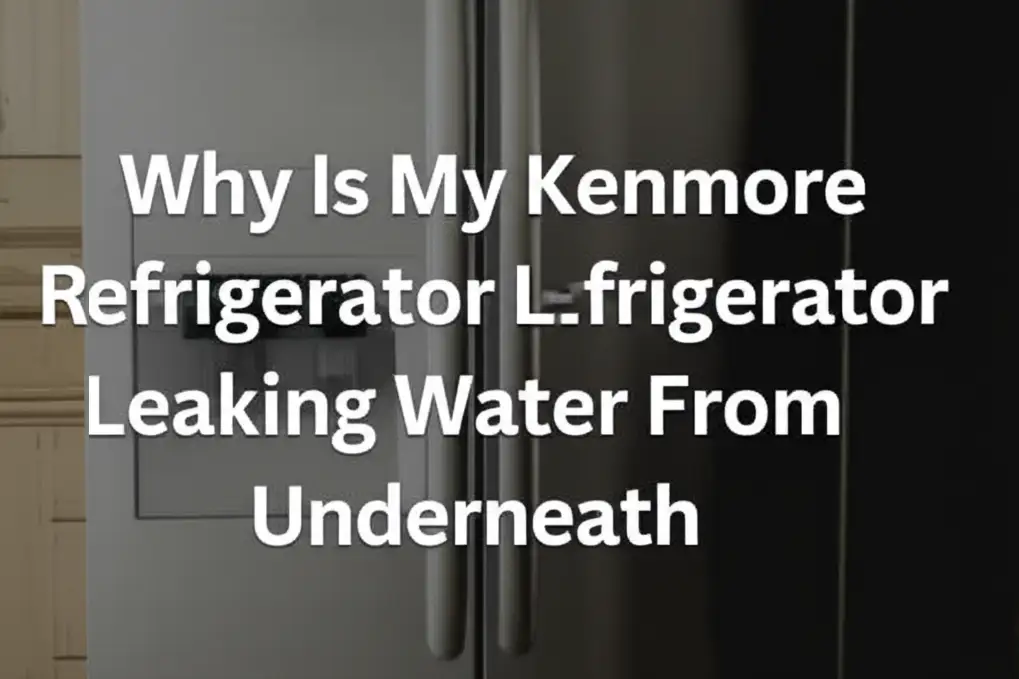· Katria Melrose · Home Appliances · 21 min read
Why Is My Kenmore Refrigerator Leaking Water From The Water Dispenser
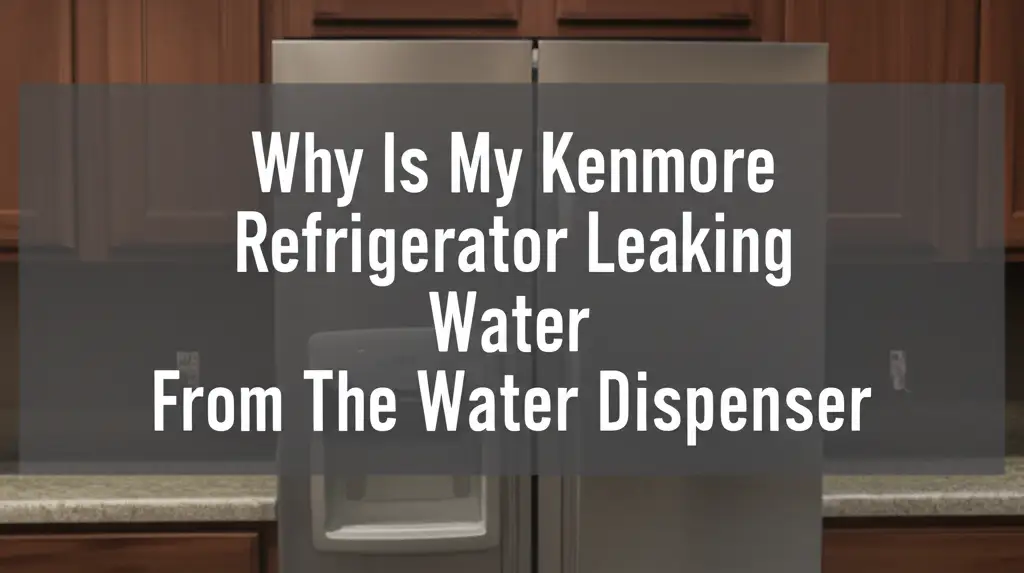
Kenmore Refrigerator Leaking from Dispenser? Here’s Why!
A dripping water dispenser on your Kenmore refrigerator can be a frustrating sight. It creates puddles on your floor, potentially damaging cabinets or flooring. You might wonder, “Why is my Kenmore refrigerator leaking water from the water dispenser?” This common issue has several potential causes. Understanding these causes helps you find a solution.
This article will help you identify the most common reasons behind your Kenmore refrigerator water dispenser leak. We will explore issues from faulty water filters to malfunctioning valves and clogged drain lines. You will learn practical troubleshooting steps and simple repair tips. By the end, you will feel confident addressing your refrigerator’s leak.
Takeaway
- Check your water filter first for improper installation or clogs.
- Inspect the water inlet valve for drips or operational issues.
- Examine the water supply line for kinks, cracks, or loose connections.
- Clear any ice or debris from the defrost drain line.
- Ensure the dispenser pad or actuator is not sticking.
- Perform regular maintenance to prevent future leaks.
Your Kenmore refrigerator leaks water from the water dispenser typically due to a faulty water filter, a malfunctioning water inlet valve, or a compromised water supply line. Other causes include a clogged defrost drain, a sticking dispenser actuator, or issues with the ice maker system. Identifying the exact source is key to a successful repair.
Understanding Your Kenmore Water Dispenser System
Your Kenmore refrigerator water dispenser is a convenient feature. It delivers chilled, filtered water on demand. The system involves several components working together. Water flows from your home’s main supply. It goes through a water filter. Then, it travels via a small line to the dispenser mechanism. When you press the dispenser lever, a valve opens. This releases water into your glass.
Any issue with these components can lead to a leak. A small crack in a line can cause a drip. A faulty valve might not close completely. Even a simple installation error can result in water escaping. Understanding this basic flow helps you pinpoint the problem when your Kenmore refrigerator starts leaking water from the water dispenser. I always start by visualizing the water path.
The dispenser also connects to the ice maker. Both systems share parts of the water supply. A problem in one area can affect the other. This interconnectedness means you need to check all related components. Proper maintenance ensures these parts function correctly. This prevents inconvenient and damaging water leaks.
Common Culprit: Faulty Water Filter or Housing
One of the most frequent reasons your Kenmore refrigerator is leaking water from the water dispenser is an issue with the water filter. This problem is often simple to fix. The filter might be improperly installed. It could also be old and clogged. Sometimes, the filter housing itself can crack.
Improper Filter Installation
When you replace your water filter, it must seat correctly. If the filter is not twisted fully into its housing, a small gap can form. Water will then bypass the seal and drip out. I have seen this happen many times. Always ensure the filter clicks into place firmly.
- Remove and Reinstall: Take the filter out completely. Align it carefully with the housing. Push it in firmly and turn it until it locks. Listen for a click or feel it tighten.
- Check the O-ring Seal: Sometimes, the small rubber O-rings on the filter or inside the housing can be damaged or missing. These seals are crucial. They create a watertight connection. If they are worn, replace the filter with a new one. New filters usually come with intact O-rings.
Clogged or Old Water Filter
An old or clogged water filter can restrict water flow. This increases pressure within the lines leading to the dispenser. Increased pressure can force water past seals that would otherwise hold. The filter might also be past its usable life. This means it can no longer process water efficiently.
- Replace the Filter: Most Kenmore filters should be changed every six months. Check your refrigerator’s manual for the exact recommendation. Replacing an old filter often solves the leak. You can also learn how to change an LG refrigerator water filter without turning off water, which provides useful general information on filter replacement. A fresh filter ensures optimal water flow and reduces pressure buildup. This reduces the risk of leaks around the dispenser.
Cracked Filter Housing
In some cases, the plastic housing that holds the water filter can develop a hairline crack. This is less common but can occur. Freezing temperatures if the fridge is in a cold garage or basement can cause this. Physical impact might also crack it. A crack allows water to escape directly from the housing.
- Visual Inspection: Carefully inspect the filter housing for any visible cracks. You might need a flashlight to see small ones.
- Professional Help: If the housing is cracked, you likely need a professional. Replacing the housing can be complex. It involves disconnecting water lines and electrical components.
Ensuring your water filter is correctly installed and regularly replaced is a simple first step. It often resolves leaks. Remember to check how to clean water filters regularly. This keeps your water fresh and prevents potential issues.
Issues with the Water Inlet Valve
The water inlet valve is a critical component in your Kenmore refrigerator’s water system. This valve controls the flow of water from your home’s supply line into the refrigerator. It opens when you request water from the dispenser or when the ice maker needs to refill. A faulty water inlet valve can cause your Kenmore refrigerator to leak water from the water dispenser.
Worn or Damaged Valve
Over time, the solenoid in the water inlet valve can wear out. The rubber seals inside the valve can also deteriorate. When this happens, the valve may not close completely after water is dispensed. A small amount of water might continue to drip. This leads to a persistent leak at the dispenser.
- Observe Drip Patterns: If the leak is a constant slow drip, even when the dispenser is not in use, the valve is a likely culprit.
- Listen for Sounds: A faulty valve might make unusual buzzing noises. This happens as it struggles to open or close properly.
Low or High Water Pressure
The water inlet valve is designed to operate within a specific range of water pressure. If your home’s water pressure is too low, the valve might not fully open. This can cause slow filling and potential pressure buildup behind the valve. If the pressure is too high, it can put excessive strain on the valve and its seals. This forces water past them.
- Check Water Pressure: You can use a water pressure gauge to test your home’s water pressure. It should typically be between 20-120 PSI for most refrigerators. Consult your Kenmore manual for the exact recommended range.
- Install a Pressure Regulator: If your home’s water pressure is consistently too high, consider installing a pressure regulator on your main water line.
Clogged Valve Screen
The water inlet valve usually has a small screen or filter where the supply line connects. This screen catches sediment and debris from your home’s water supply. If this screen becomes clogged, it can restrict water flow. This affects the valve’s operation. It can also cause pressure imbalances that lead to leaks.
- Turn Off Water Supply: Before inspecting the valve, turn off the water supply to your refrigerator. You will find the shut-off valve behind the fridge or under the sink.
- Disconnect and Inspect: Disconnect the water line from the inlet valve. Carefully remove and inspect the screen. Clean it with a small brush or replace it if it’s damaged.
- Test Valve Operation: Once the screen is clean and reconnected, turn the water supply back on. Test the dispenser to see if the leak persists.
Replacing a faulty water inlet valve is often a DIY task for those comfortable with basic appliance repairs. Always ensure you disconnect power and water before attempting any repairs on the valve.
Problems with the Water Supply Line
The water supply line connects your Kenmore refrigerator to your home’s main water source. It runs from the wall valve to the refrigerator’s water inlet valve. Any issue along this line can cause your Kenmore refrigerator to leak water from the water dispenser. This can be one of the easier leaks to spot, as the water path is often visible.
Kinks or Pinches in the Line
The water supply line, especially if it’s made of plastic, can easily become kinked or pinched. This often happens if the refrigerator is pushed too close to the wall. A kink restricts water flow. It can also create pressure points within the line. This increased pressure can lead to leaks at connection points or even cause a small rupture in the line itself.
- Pull Out the Refrigerator: Carefully pull your Kenmore refrigerator away from the wall.
- Inspect the Entire Line: Examine the water line from the wall connection to the refrigerator’s back. Look for any sharp bends, kinks, or areas where the line might be compressed.
- Straighten or Reroute: Gently straighten any kinks. If necessary, reroute the line to ensure it has enough slack and is not pinched against the wall or other objects.
Loose Connections
Over time, the fittings connecting the water supply line to the wall valve or the refrigerator’s inlet valve can loosen. Vibrations from the refrigerator or slight movements can cause this. Even a small loosening can allow water to drip out. This drip can then travel along the line or inside the refrigerator, appearing at the dispenser.
- Tighten Connections: With the water supply turned off, use a wrench to gently tighten all connections on the water supply line. Do not overtighten, as this can damage the fittings or lines.
- Check for Corrosion: Look for signs of corrosion around the connections. Corrosion can weaken the seal.
Cracked or Damaged Line
The water supply line itself can develop cracks or small holes. This might happen due to age, material fatigue, or accidental damage. Plastic lines are more prone to this than copper lines. A crack will cause a direct leak. The water then finds its way to the lowest point, which might be near the dispenser area.
- Thorough Visual Inspection: Inspect the entire length of the water line for any visible cracks, punctures, or signs of wear. Pay close attention to areas that bend or rub against other surfaces.
- Replace the Line: If you find any damage to the water supply line, replace it immediately. You can purchase replacement lines at most hardware stores. Ensure the new line is the correct length and material (typically braided stainless steel or new, flexible PEX tubing for durability).
- Consider Upgrading: If you have an old plastic water line, consider upgrading to a more durable braided stainless steel line. These are more resistant to kinks and cracks.
Addressing issues with the water supply line often involves turning off the main water to your refrigerator. Always be careful when working with water lines to avoid further leaks or damage.
Clogged or Frozen Defrost Drain Line
While the defrost drain line isn’t directly part of the water dispenser mechanism, a clog or freeze in this line can lead to water leaking from unexpected places, including the dispenser area. Your Kenmore refrigerator uses a defrost cycle to melt frost from the evaporator coils. The melted water then flows down a drain line to a drain pan under the fridge.
How a Clog Causes a Leak
If this drain line becomes clogged, the melted water has nowhere to go. It overflows the drain trough. This water can then spill into the freezer compartment. It might pool at the bottom. From there, it can seep out through seams or channels. This includes the path that leads to the water dispenser. It can look like the Kenmore refrigerator is leaking water from the water dispenser.
- Food Debris: Food particles or ice chips can fall into the drain opening. They can block the drain.
- Ice Buildup: If the refrigerator’s temperature is too low, or if the defrost heater isn’t working right, ice can build up. This ice can block the drain line.
Identifying a Clogged Defrost Drain
You might notice a few signs. Water pooling inside the freezer bottom is a strong indicator. You might also see ice accumulating where it shouldn’t, like on the freezer floor. If the leak is sporadic and seems to happen after the defrost cycle, this is likely the cause.
- Check the Freezer Floor: Open your freezer door. Look for standing water or excess ice on the bottom surface.
- Inspect the Drain Tube: The drain tube is usually located at the back of the freezer compartment, below the evaporator coils. It might be hidden behind a panel.
Clearing the Defrost Drain
Clearing a clogged or frozen defrost drain is a common repair. It does require some access to the back of the freezer.
- Unplug the Refrigerator: Always disconnect power before working inside.
- Remove Freezer Contents and Shelves: Clear out everything to gain access.
- Locate the Evaporator Cover: You will typically need to remove a back panel in the freezer. This exposes the evaporator coils and the drain trough.
- Melt Ice: Use a hairdryer on a low setting or pour warm water into the drain hole. This melts any ice blockage. Be careful not to damage plastic components.
- Clear Debris: Use a small, flexible brush or a turkey baster to clear any visible food particles or sludge. Some people use a mixture of warm water and a little baking soda.
- Clean the Drain Pan: The drain pan under the refrigerator might also have debris. Access it from the back or front of the unit and clean it. This prevents future clogs.
Once the drain is clear, water should flow freely to the drain pan. This resolves the overflow issue. This problem often causes “Why is my Whirlpool side-by-side refrigerator leaking water from the bottom?” or “Why is my Frigidaire refrigerator leaking water out the front bottom” symptoms as well. So, consider these tips for other models.
Dispenser Actuator or Pad Malfunction
The dispenser actuator or pad is the part you press to get water. It activates a switch, which then signals the water inlet valve to open. If this component malfunctions, it can cause your Kenmore refrigerator to leak water from the water dispenser. This issue might result in constant dripping or a failure to stop water flow.
Sticking Dispenser Lever or Pad
Sometimes, the dispenser lever or pad can get stuck in the “on” position. This might be due to food residue, sticky liquids, or a broken spring mechanism. If it sticks, the internal switch remains engaged. This keeps the water valve open, causing a continuous drip or stream.
- Clean the Area: Use a damp cloth to thoroughly clean the dispenser lever and the surrounding area. Remove any sticky spills or debris. You can also learn how to clean your refrigerator’s water dispenser or how to clean your refrigerator’s water dispenser of mold for a more in-depth approach.
- Test the Lever: Gently press and release the lever multiple times. Ensure it springs back fully to its original position each time. If it feels stiff or doesn’t return, something might be impeding its movement.
Faulty Dispenser Switch
Behind the dispenser lever is a small electrical switch. This switch sends the signal to the water inlet valve. If this switch is faulty or broken, it might send a constant “open” signal. This keeps the valve activated even when you release the lever.
- Check for Continuity (Advanced): If you are comfortable with electrical testing, you can use a multimeter to check the continuity of the switch. This usually requires disassembling part of the dispenser assembly.
- Visual Inspection: Look for any visible damage to the switch or its wiring.
Damaged Dispenser Nozzle
The nozzle is the small opening where water comes out. Over time, mineral deposits can build up inside the nozzle. This can obstruct water flow and cause it to spray unevenly. In rare cases, the nozzle itself can crack. A cracked nozzle will leak water directly.
- Inspect the Nozzle: Look closely at the very tip of the dispenser nozzle. Check for cracks, chips, or excessive mineral buildup.
- Clean the Nozzle: Use a small brush or a toothpick to gently clear any debris or mineral deposits from the nozzle opening. A solution of vinegar and water can help dissolve mineral buildup. You can also find tips on how to clean the water dispenser on your fridge.
If the dispenser lever or switch is physically broken, it will likely require replacement. These parts can often be ordered from appliance parts suppliers. For complex electrical issues, consulting a professional technician is advisable.
Overfilled Ice Maker or Drain Pan Issues
While an ice maker is distinct from the water dispenser, issues with it can sometimes cause water to appear to leak from the dispenser area. Both systems share parts of the water supply. An overfilling ice maker or a problem with its drain can lead to water overflow. This water then flows down and out of the freezer, potentially appearing at the front, near the dispenser.
Overfilling Ice Maker
An ice maker fills with water to create ice cubes. If the fill cycle is too long or the water inlet valve for the ice maker is faulty, it can overfill. This means too much water flows into the ice maker mold. The excess water then spills out of the ice maker assembly.
- Observe Fill Cycle: Pay attention when your ice maker fills. Does it seem to take too long? Does water slosh over the edges of the mold?
- Check Water Inlet Valve: The ice maker has its own water inlet valve, often separate from the main dispenser valve. A faulty valve can drip continuously or allow too much water through. This is similar to why a GE refrigerator water dispenser is not working after replacing the filter; the valve could be faulty.
- Adjust Water Level: Some ice makers have an adjustment screw to control the water fill level. Consult your Kenmore refrigerator manual to see if your model has this feature and how to adjust it.
Cracked Ice Maker Mold or Tray
The plastic mold where ice cubes form can develop cracks over time. If the mold is cracked, water will leak out before it even freezes. This water can then flow down the inside of the freezer door or cabinet. It might then drip out from around the dispenser.
- Visual Inspection: Carefully remove the ice maker assembly. Inspect the ice cube mold for any visible cracks or damage.
- Replacement: If the ice maker mold is cracked, it usually requires replacing the entire ice maker assembly.
Clogged Ice Maker Drain Tube
Some ice makers have a small drain tube. This tube allows any melted ice or excess water to drain away. If this drain tube gets clogged with ice or debris, water can back up. It then overflows the ice maker area.
- Locate and Clear: Identify the ice maker’s drain tube. It might be difficult to access without removing the ice maker. Clear any obstructions with warm water or a small tool.
When troubleshooting leaks, check both the dispenser and ice maker systems. Water travels, and the source might not be exactly where the drip appears. Ensuring all components are functioning correctly prevents frustrating water leaks. This issue can also relate to why a side-by-side refrigerator leaks water on the floor, as water can travel down.
Regular Maintenance to Prevent Kenmore Dispenser Leaks
Preventing water leaks from your Kenmore refrigerator’s water dispenser often comes down to regular, proactive maintenance. Simple checks and routine cleaning can save you from inconvenient and potentially damaging water spills. Don’t wait for a leak to start before you act.
Consistent Filter Replacement
Your water filter is the first line of defense for clean water. It also plays a role in preventing leaks. An old, clogged filter restricts water flow and increases pressure. This increased pressure can stress connections and seals. It can force water out where it shouldn’t be.
- Follow Manufacturer Guidelines: Kenmore recommends changing your water filter every six months. If you have particularly hard water or use the dispenser frequently, you might need to change it more often.
- Use Genuine Filters: Always use genuine Kenmore replacement filters or filters explicitly approved for your model. Off-brand filters might not fit perfectly. This can lead to poor sealing and leaks.
- Proper Installation: Each time you change the filter, ensure it is seated correctly. Push it in firmly and turn it until it locks securely into place. Listen for the click.
Inspecting Water Lines and Connections
The water lines are constantly under pressure. They can wear down or loosen over time. A quick visual inspection can catch potential problems before they become major leaks.
- Pull Out the Refrigerator: Periodically, gently pull your Kenmore refrigerator away from the wall.
- Check the Supply Line: Inspect the entire length of the water supply line. Look for kinks, cracks, or signs of wear. Ensure it’s not pinched against the wall or other appliances.
- Tighten Connections: With the water turned off, use a wrench to snug up the connections at the wall valve and the refrigerator’s inlet valve. Be careful not to overtighten.
Cleaning the Dispenser Area
The dispenser tray and nozzle can accumulate mineral deposits and debris. While not always a direct cause of leaks, a very clogged nozzle can lead to drips. A dirty tray can also overflow.
- Regular Cleaning: Wipe down the dispenser area regularly. Remove any spills or mineral buildup. You can use a damp cloth and mild soap.
- Nozzle Care: Occasionally, use a small brush or toothpick to clear the dispenser nozzle opening. This ensures free water flow. For comprehensive cleaning, learn how to clean a water dispenser on your fridge.
Clearing the Defrost Drain
A clogged defrost drain is a common cause of internal water pooling. This water can then find its way out through the dispenser. Including this in your maintenance routine is smart.
- Periodic Check: If you notice ice buildup in the freezer bottom, address it promptly.
- Clear the Drain: Refer to the “Clogged or Frozen Defrost Drain Line” section for detailed steps on clearing it.
By adopting these simple maintenance practices, you can significantly reduce the likelihood of your Kenmore refrigerator leaking water from the water dispenser. Proactive care ensures your appliance runs smoothly and leak-free for longer.
Frequently Asked Questions About Kenmore Refrigerator Leaks
Why does my Kenmore fridge water dispenser keep dripping after use?
A persistent drip after using your Kenmore water dispenser often points to a faulty water inlet valve or a problem with the dispenser actuator. The valve might not be closing completely, or the actuator could be sticking. Mineral buildup in the nozzle can also cause drips. Inspect the valve and clean the dispenser area thoroughly.
How often should I change my Kenmore refrigerator water filter?
Kenmore generally recommends replacing your refrigerator’s water filter every six months. However, if you have hard water, use the dispenser very frequently, or notice a decrease in water flow or taste, you might need to change it more often. Always refer to your specific model’s manual.
Can a bad water filter cause a Kenmore refrigerator to leak?
Yes, a bad or improperly installed water filter is a very common cause of leaks in Kenmore refrigerators. An old or clogged filter can increase water pressure within the system, forcing water past seals. An incorrectly seated filter or one with damaged O-rings will also allow water to escape from its housing.
Is it safe to use a Kenmore refrigerator if the water dispenser is leaking?
It is generally not safe to ignore a leaking Kenmore refrigerator. Even a small leak can cause significant damage to your flooring, cabinets, and the refrigerator itself over time. It can also create a slip hazard or lead to mold growth. Address the leak as soon as you discover it.
How do I access the water line on my Kenmore refrigerator?
To access the main water supply line, gently pull your Kenmore refrigerator away from the wall. The water line typically connects to a small valve on the wall and then enters the back of the refrigerator. You may need to remove a lower rear panel on the appliance to fully inspect the line inside the unit. Always disconnect power and water first.
When should I call a professional for a Kenmore dispenser leak?
You should call a professional if you have tried basic troubleshooting steps and cannot identify or fix the source of the leak. If the repair involves complex electrical components, sealed systems, or if you are uncomfortable working with water lines and tools, a qualified appliance technician is your best option.
Conclusion
Finding your Kenmore refrigerator leaking water from the water dispenser can be concerning. However, as we’ve explored, many common causes are fixable with a bit of troubleshooting. From an improperly installed water filter to a faulty water inlet valve or a simple kink in the supply line, understanding the typical culprits helps you pinpoint the problem.
Remember to always start with the easiest solutions, like checking your water filter and ensuring all connections are snug. Don’t overlook issues like a clogged defrost drain or a sticking dispenser actuator, as these can also lead to mysterious leaks. By taking a systematic approach, you can often resolve the issue yourself. If you’ve tried these steps and your Kenmore refrigerator is still leaking water from the water dispenser, don’t hesitate to consult a professional appliance technician. Protecting your home and ensuring your refrigerator runs efficiently is always worth the effort. Take action today and get your Kenmore back to its leak-free best!
- Kenmore refrigerator leak
- water dispenser leak
- refrigerator repair
- Kenmore appliance
- fridge troubleshooting
- Kenmore water dispenser
- appliance maintenance


